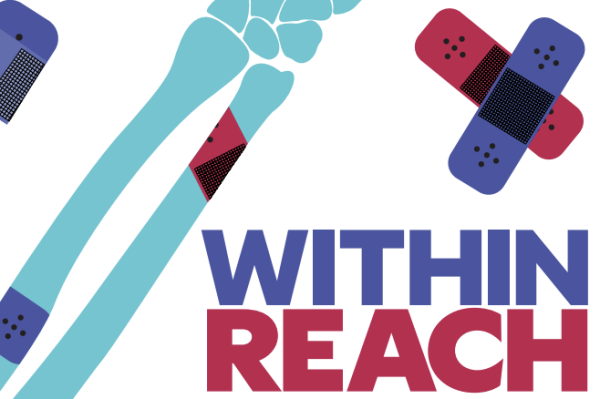Painted Poison
A Louisville family faces a silent threat: the lead paint in their home.
Photos by Lainey Holland
Looking out the front door of her grandmother’s house in the Oakdale neighborhood near Churchill Downs, one-year-old Roxanne (Roxy) Price watches pedestrians and traffic on the road on Oct. 16. Just outside the doorframe and on the windows, columns, and the roof hid the danger beneath the cracked paint that caused Roxy to get lead poisoning.
Roxanne Price pushed open the crimson curtains to reveal a window regularly smudged with her sticky prints. We watched as she pressed a small hand against the glass; her blue eyes stared longingly at the cars that whizzed past. Her nose was smushed against the window, leaving a foggy imprint behind in its place.
The white paint coating the frame of the front door was visibly tarnished with years of neglect. Cracked paint hinted at the danger that lay beneath.
On that October day, Roxanne could not go past the white door, even though she desperately wanted to. She could not play in the front yard or even stand on the porch.
Just months ago in July, Roxanne sat with her mother, Christina Allemang, in a doctor’s office for a regular checkup, when the doctor said something strange to the family.
Roxanne had lead poisoning.
Lead — as in a soft metal that is in the paint of most old homes in Louisville.
Poisoning — as in Christina and Jeremy Price, Roxanne’s father, might have to worry about their daughter growing up with mental impairments that could impact her ability to live a normal life.
What’s the issue?
Lead can take many forms, but the most common source of exposure is through the paint in homes. If paint starts to chip or peel, families are at risk of lead exposure, and high levels of exposure can create health problems. While lead in the bloodstream is extremely harmful for anyone, it is especially dangerous for the primarily affected group — children under the age of 12. The substance’s chemical makeup confuses their young bodies.
“When it’s ingested, even as just kind of a little bit of dust, the body thinks that it’s calcium. That’s why children absorb so much,” said John Cullen, founder of LockUp Lead, a local company that provides communities with simple-to-use lead testers. “They need a lot of calcium for their bones, so they accumulate this and nothing in the body that usually would weed out poisons always recognizes it as a poison.”
Roxanne, who was ingesting lead paint chips scattered around her house, was unknowingly poisoning herself. Without the financial ability to afford the safe removal of the peeling, lead-based paint from their home, they were forced to leave.
For many others like Christina and Jeremy, living in older areas around Louisville and across the U.S., this problem is not uncommon. Lead-based paints were banned in the U.S. in 1978, but the danger of lead exposure is still a threat to families living in houses built before the regulations. Mostly, residents cope with the problem by painting over it with newer, latex-based paints.While renovations to remove the lead are an option for some, the complete removal of lead can bring about significant costs unrealistic for the families where it’s most concentrated.
According to the Louisville Metropolitan Housing Coalition, poverty continues to concentrate within the city’s west and south-central areas. It’s here that a majority of older, unrenovated homes sit, hiding the threats under their chipping exteriors. For many families, the low pricing makes these homes reasonable options.
“The deal was too good to be true,” Jeremy said. “You know, $625 a month for a house. You can’t even get a one-bedroom apartment for that.”
Starting over
While the price on the house was low, the price they paid for their daughter’s health turned their lives upside down.
The car ride home from the pediatrician was a tense, quiet one. Christina tried to keep her composure, knowing she would later have to tell Jeremy that the home where both of their daughters grew up was no longer a safe place for them to live.
“Yeah, I was sad,” Christina said. “I mean, that’s my baby.”
In just three or four hours, Christina, Roxanne, and Autumn, Roxanne’s nine-year-old sister, were off to Christina’s mother’s house, leaving Jeremy behind with the looming threat of lead in their home.
On Oct. 13, Jeremy sat with us in the booth of a local restaurant, explaining the events that had unfolded over the past year. A short distance away, tables were crowded with families and other customers whose indistinct mumbles filled the air; lively music played quietly over the speakers as waiters shuffled around the room.
“My personal reaction… ” he said, pausing as he remembered Roxanne getting sick.
He stared off into the distance before he hid his face in his open palms. After a minute, he looked back up again, slowly taking a sip of his drink, attempting to regain his composure. He carefully wiped his eyes and continued on.
“Reality started kicking in, you know what I mean,” he said, clearing his throat.
Jeremy reassured us that he was okay, and kept going.
“It’s hard. I should’ve did this, did that. And what it all boils down to is the amount of money you have, you know, and that determines where you go, what you can and can’t do. When you got kids, you gotta do what you gotta do.”
Jeremy’s reaction was our first glimpse into the extremity of the issue; we could now put a face to a problem we were struggling to understand.
For Justin, one of the writers of this story, it was especially eye-opening. Jeremy wasn’t just someone in a news story; he was Justin’s family, a distant cousin. The pain on Jeremy’s face painted a picture of a father unknowingly raising his children in an unsafe environment, despite doing the best he could. At the beginning of the writing process, the facts and statistics Justin researched pushed the family’s trauma out of view. But now, it was no longer an intangible phenomenon, but a harsh reality. His own financial advantages had shielded him from ever having to face what people in his community — people in his own family — faced every day.
While Christina, Roxanne, and Autumn moved into Christina’s mother’s house, Jeremy stayed behind, determined to get his deposit back while holding onto the hope that it would one day be their family’s home again.
However, the situation did not disappear. It got worse. In fact, it got so bad that the house was deemed by the health department as no longer safe for Jeremy to live in as an adult.
Thus began a grueling journey of couch surfing and long nights at work that often ended with Jeremy sleeping in his car.
“I was just trying to stay at work as much as possible so I could get the money to do what I gotta do,” Jeremy said.
It was a difficult and painful ordeal. The place Jeremy and his family once called home was beyond reasonable repair. They needed to find another option, and fast.
Life with lead
We entered Christina’s mother’s house on Oct. 16. A welcome mat greeted visitors at the front door. Inside, the hardwood floors were hidden by a sea of children’s toys, from stuffed teddys to scattered building blocks. A children’s TV show played quietly in the background as Roxanne giggled, stepping on her mother’s feet.
While Christina was grateful they could move in her mother’s home just a few miles away, the house was supposed to be an escape for Roxanne. The place she had lived in since birth was no longer safe for her, and it was crucial to her health that she move out. Unfortunately, they realized this home was also in an area notorious for its lead, and removing the paint was not an option, once again.
Beneath the surface, this environment was far from welcoming. Christina had to keep a mat at the front door to catch any lead residue accumulating on the bottoms of their shoes throughout the day, making sure it was wiped off before they entered the house. The living room, unlike the barren front yard, was filled with toys. Because of the lead in the soil, stuffed animals and Barbie dolls were Roxanne’s only taste of a normal childhood. The same toxic paint that coated walls was also in paint on the roof. When it began to rain, the old paint started to chip, dripping off the roof and into the grass and the soil where Christina’s mother once grew vegetables.
Because of these hazards, practically nowhere was safe for a small child. Roxanne’s entire world was behind the front door — a barrier to a life beyond lead.
It was up to Christina to provide her daughter with small distractions that could help them make the best of a bad situation. Although it could never compare to a yard of their own, trips to Iroquois Park brought some light to the darkness that had crept into their life. Here, the situation at home could be left out of sight, even if just for a minute.
But there was hope for this family. Roxanne was able to get the treatment she needed to get her lead levels down through an alternative diet and monthly blood tests. Because of this, she will avoid long term physical and mental health effects as she grows older.
However, some people aren’t as lucky. Eric Roberts, a researcher from the American Academy of Pediatrics, found that nearly 50% of the approximate 1.2 million cases of children suffering from lead poisoning were not reported.
According to the CDC, children and adults regularly exposed to lead can have immediate short-term physical symptoms such as abdominal pain, constipation, irritable moods, loss of appetite, frequent headaches, and memory loss. While the physical symptoms eventually disappear, what’s left behind is stunted brain development and the possibility of mental disabilities that, more often than not, are permanent.
Prevent the poison
Like the Price family, John Cullen became aware of this phenomenon when his own son, Jack, had evidence of higher lead levels at a young age.
“I was renovating older houses kind of part time with my wife while I was doing city planning work,” Cullen said.
While he worked in these older areas, he came into contact with the harmful dust hidden from view, collecting on the bottoms of his shoes. Each day as he came home, Cullen was unknowingly leaving behind a toxic trail — one that would put Jack in immense danger.
Over time, and without their knowledge, the substance accumulated within the young family’s home.
Thankfully, the Cullens caught the issue early on before it spiraled into something that would permanently affect their son. Despite this positive outcome, the incident was too close of a call for them, fueling Cullen to abandon his career and focus on a solution that would eliminate the chances of any other family having to experience the same nightmare he had.
“It’s really a kind of hidden secret. People have been happy to kind of sweep it under the rug,” Cullen said.
Because of Jack’s experience, Cullen founded LockUp Lead in 2008. They offer an instant test kit that colors paint bright red wherever lead is present. They also have a spray bottle that neutralizes the red spots, making the lead less likely to be absorbed by the body. These can be used on window sills, door jams, and, of course, walls. It’s a cost-effective solution to identifying and eradicating the threat of lead exposure in homes.
The company started as just a Louisville project but blossomed into a nationwide movement, aiding families from small homes in the Louisville area to the White House.
“President Bush’s dog got lead poisoning in the White House when they were doing some renovations,” Cullen said. “When Michelle Obama learned that, she told us that they were doing renovations now, and she lived there with her daughters so she wanted us to send her some LockUp Lead products. That was a pretty thrilling delivery.”
While Cullen and his company love these national deliveries and want their company to soar, their main focus has always been on the local, lower-income communities and helping them live in safe homes. LockUp Lead teamed up with Louisville Metro Housing Coalition to give housing options to families that are displaced because of lead exposure, just like Jeremy’s.
Fortunately, you don’t have to suddenly become an entrepreneur and develop your own products to help with the ongoing lead crisis. As this problem has become more and more nationally recognized, companies and organizations have been popping up all over the country to educate communities and offer ways to help.
The Childhood Lead Poisoning Prevention Program, a program of the Centers for Disease Control (CDC), attends community events around Louisville to provide free educational materials about lead and lead removal. Additionally, they strongly encourage all children and adults in lead-concentrated areas to be tested, even if you are unsure if it is a problem. Their page on cdc.gov gives information on what lead is, what it means for all parties involved, and what you and your family can do to remove it.
Catching high lead levels early is very important but often difficult when dealing with such an invisible problem. Raising awareness of programs like these and reiterating the extremity
of lead poisoning can save children from a life of diminished mental capabilities.
Another small, but effective way to combat lead poisoning is by both encouraging and participating in a lead-safe, nutritional diet. Because the body mistakes the metal as calcium, it automatically absorbs it into the bloodstream. Promoting a diet rich in calcium, vitamin C, and iron lessens the likelihood of the lead entering the blood and, in turn, lessens the symptoms later on.
Looking ahead
A month later, we walked up unfamiliar front steps, gazing at the home that would foster new beginnings for Roxanne’s family. It was a stark contrast to the decaying facade we were met with at their former home. Inside, the clean front room gave no hint of the tension in their previous household. Roxanne’s ordeal would no longer have to be the center of the family’s world.
This wasn’t a typical move; rather than stacked boxes and displaced furniture, the space was mostly empty, other than the single fold out chair and newly purchased La-Z-Boy.
“We’re planning on buying mostly new stuff — not because of the lead but because of the memories. We just want to start over,” Christina said.
The family was opening the door to their future — leaving behind restricted diets and monthly lead tests for a future of lazy backyard pool days.
“The neighborhood’s better and they can go outside and play,” Christina said. “We don’t have to be so scared of lead all the time.” •
Donations are collected through The Publishers, duPont Manual High School's booster club for J&C. On The Record relies completely on sponsorships, advertisements, and donations to produce and distribute each issue. Please consider donating to our cause, and helping the student journalists of OTR amplify youth voices for years to come.









